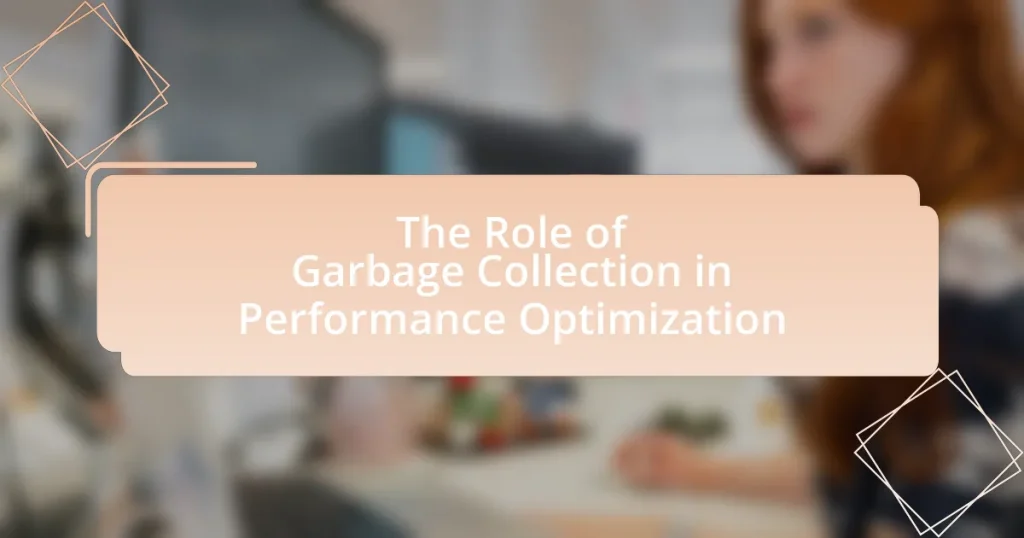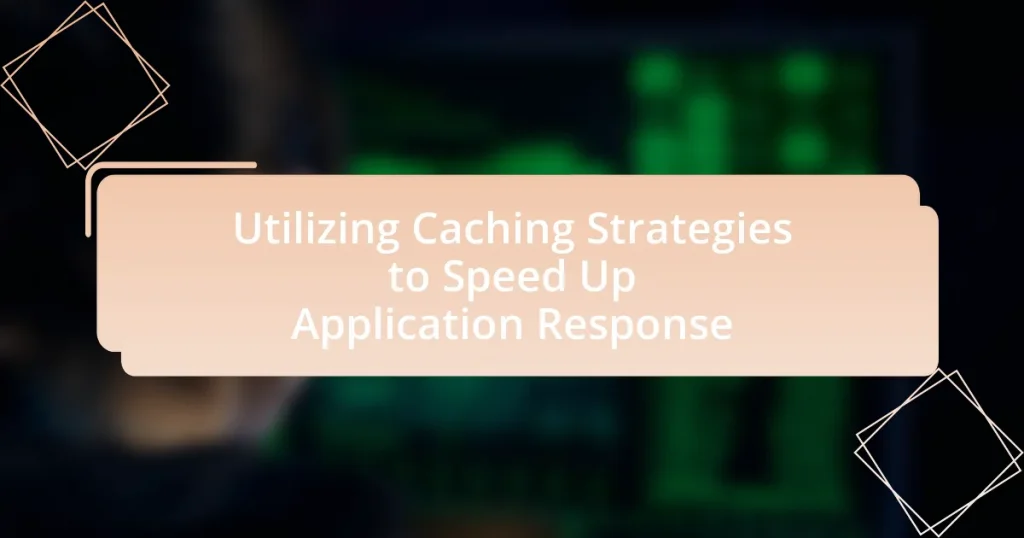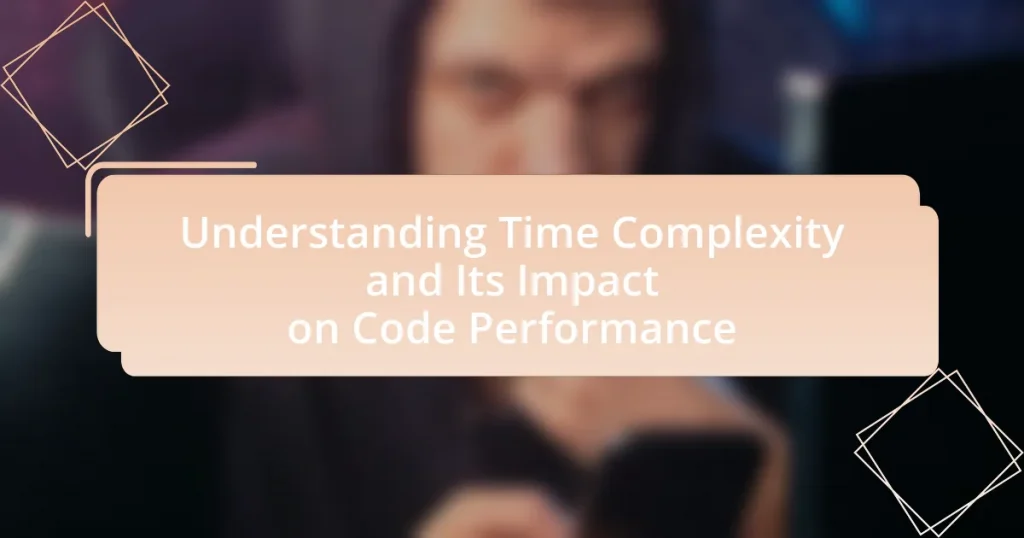Garbage collection is a critical process in performance optimization, responsible for automatically reclaiming memory that is no longer in use, thereby preventing memory leaks and fragmentation. This article explores the mechanisms of garbage collection, including reference counting, mark-and-sweep, and generational collection, and their impact on application performance and responsiveness. It also discusses the importance of optimizing garbage collection through tuning, minimizing object creation, and employing concurrent and parallel techniques to reduce pause times. Additionally, the article highlights future trends, such as the integration of machine learning in garbage collection strategies, aimed at enhancing efficiency and resource utilization in memory management.
What is the Role of Garbage Collection in Performance Optimization?
Garbage collection plays a crucial role in performance optimization by automatically reclaiming memory that is no longer in use, thus preventing memory leaks and fragmentation. This process enhances application performance by ensuring that memory resources are efficiently managed, allowing for smoother execution of programs. Studies have shown that effective garbage collection can lead to significant improvements in application responsiveness and throughput, particularly in environments with high object allocation rates. For instance, the Java Virtual Machine (JVM) employs various garbage collection algorithms that adapt to application behavior, optimizing memory usage and reducing pause times, which directly impacts overall performance.
How does Garbage Collection contribute to system performance?
Garbage Collection enhances system performance by automatically reclaiming memory that is no longer in use, thus preventing memory leaks and fragmentation. This process allows applications to run more efficiently by ensuring that memory resources are optimally utilized. For instance, in environments like Java, the Garbage Collector can improve throughput by minimizing the time spent on manual memory management, allowing developers to focus on application logic rather than memory allocation. Studies have shown that effective Garbage Collection can lead to a reduction in application latency and an increase in overall system responsiveness, as it helps maintain a healthy memory state and reduces the risk of out-of-memory errors.
What are the key mechanisms of Garbage Collection?
The key mechanisms of Garbage Collection include reference counting, mark-and-sweep, and generational collection. Reference counting tracks the number of references to each object, deallocating memory when the count reaches zero. Mark-and-sweep involves two phases: marking reachable objects and sweeping through memory to reclaim space from unmarked objects. Generational collection optimizes performance by categorizing objects based on their lifespan, collecting younger objects more frequently while promoting older objects to a longer-lived space. These mechanisms enhance memory management efficiency, reduce fragmentation, and improve application performance by ensuring that unused memory is reclaimed promptly.
How does Garbage Collection manage memory allocation?
Garbage Collection manages memory allocation by automatically reclaiming memory that is no longer in use, thus preventing memory leaks and optimizing resource utilization. It identifies objects that are no longer reachable from the root references and marks them for deletion. This process typically involves algorithms such as mark-and-sweep, where the collector first marks all reachable objects and then sweeps through memory to free unmarked objects. The efficiency of Garbage Collection is crucial for performance optimization, as it reduces the need for manual memory management and minimizes fragmentation, leading to improved application responsiveness and stability.
Why is Garbage Collection important for application performance?
Garbage Collection is important for application performance because it automatically manages memory allocation and deallocation, preventing memory leaks and fragmentation. Efficient garbage collection ensures that unused objects are promptly removed from memory, which optimizes resource utilization and enhances application responsiveness. Studies have shown that applications with effective garbage collection mechanisms can experience up to a 30% improvement in performance due to reduced memory overhead and faster execution times.
What impact does Garbage Collection have on application responsiveness?
Garbage Collection negatively impacts application responsiveness by introducing pauses during memory management processes. These pauses occur when the garbage collector identifies and reclaims unused memory, which can lead to noticeable delays in application performance. For instance, in Java applications, the Stop-The-World (STW) events during garbage collection can cause latency spikes, affecting user experience. Studies have shown that frequent or lengthy garbage collection cycles can lead to increased response times, particularly in real-time applications where low latency is critical.
How does Garbage Collection affect resource utilization?
Garbage Collection affects resource utilization by automatically reclaiming memory that is no longer in use, which optimizes memory management and reduces memory leaks. This process can lead to improved application performance by freeing up resources that can be reallocated for active processes. However, it can also introduce overhead during the collection process, temporarily consuming CPU cycles and potentially causing pauses in application execution. Studies have shown that efficient garbage collection algorithms can significantly enhance resource utilization, as evidenced by research indicating that optimized garbage collection can reduce memory usage by up to 30% in certain applications.
What are the different types of Garbage Collection algorithms?
There are several types of Garbage Collection algorithms, including Mark-and-Sweep, Reference Counting, Generational Garbage Collection, and Tracing Garbage Collection. Mark-and-Sweep identifies live objects and reclaims memory from unreachable objects, while Reference Counting keeps track of the number of references to each object and deallocates memory when the count reaches zero. Generational Garbage Collection optimizes performance by segregating objects by their age, collecting younger objects more frequently, and Tracing Garbage Collection uses a graph traversal method to identify live objects. These algorithms are essential for managing memory efficiently and improving application performance.
How do generational Garbage Collection algorithms work?
Generational Garbage Collection algorithms work by categorizing objects into different generations based on their age, which optimizes memory management and improves performance. The primary concept is that most objects are short-lived, so the algorithm segregates newly created objects into a young generation and promotes long-lived objects to an older generation.
When garbage collection occurs, the algorithm primarily focuses on the young generation, where it can quickly reclaim memory from objects that are no longer in use. This approach reduces the overhead associated with scanning the entire heap, as older generations are collected less frequently, reflecting the observation that older objects tend to have longer lifetimes.
Research has shown that this method significantly enhances performance; for instance, studies indicate that generational garbage collection can reduce pause times and improve throughput in applications with high object allocation rates.
What are the advantages of using generational Garbage Collection?
Generational Garbage Collection offers several advantages, primarily improved performance and efficiency in memory management. This approach categorizes objects by their lifespan, allowing the system to focus on collecting short-lived objects more frequently while minimizing the overhead associated with long-lived objects. As a result, it reduces the frequency of full memory scans, which can be time-consuming.
Research indicates that generational Garbage Collection can lead to significant performance enhancements; for instance, studies have shown that it can reduce pause times by up to 50% compared to non-generational methods. This efficiency is particularly beneficial in applications with high object allocation rates, as it optimizes memory usage and enhances overall application responsiveness.
How does generational Garbage Collection optimize memory usage?
Generational Garbage Collection optimizes memory usage by categorizing objects based on their lifespan, which allows for more efficient memory management. This technique leverages the observation that most objects are short-lived, enabling the garbage collector to focus on collecting these ephemeral objects more frequently while minimizing the overhead associated with long-lived objects. By segregating memory into generations—typically young, old, and sometimes permanent—this method reduces the frequency of full memory scans, thereby improving performance and reducing pause times. Studies have shown that generational collection can lead to significant reductions in memory fragmentation and overall memory usage, as it efficiently reclaims memory from objects that are no longer needed.
What is the role of concurrent and parallel Garbage Collection?
Concurrent and parallel garbage collection plays a crucial role in optimizing application performance by minimizing pause times during memory management. Concurrent garbage collection allows the application to continue running while the garbage collector identifies and reclaims unused memory, thus reducing the impact on application responsiveness. Parallel garbage collection, on the other hand, utilizes multiple threads to perform garbage collection tasks simultaneously, which speeds up the process and further decreases pause times. This dual approach enhances throughput and ensures that applications remain responsive, particularly in environments with high memory allocation and deallocation rates.
How do concurrent Garbage Collection techniques improve performance?
Concurrent Garbage Collection techniques improve performance by allowing the application to continue executing while garbage collection occurs in parallel. This reduces pause times associated with traditional garbage collection methods, which can halt application threads, leading to noticeable latency. For instance, in the Java Virtual Machine, concurrent collectors like the Garbage-First (G1) collector can reclaim memory without significant interruptions, thus maintaining application responsiveness. Studies have shown that using concurrent techniques can lead to a reduction in pause times by up to 50%, enhancing overall throughput and user experience in applications that require high availability.
What are the trade-offs of using parallel Garbage Collection?
Parallel Garbage Collection improves performance by utilizing multiple threads to reclaim memory, which can significantly reduce pause times during garbage collection cycles. However, the trade-offs include increased CPU usage and potential contention among threads, which may lead to diminishing returns in performance, especially in applications with low memory allocation rates. Additionally, the complexity of implementation can lead to challenges in tuning and optimizing the garbage collector for specific workloads, potentially resulting in suboptimal performance if not configured correctly.
How can developers optimize Garbage Collection for better performance?
Developers can optimize Garbage Collection for better performance by tuning the garbage collector settings and minimizing object creation. Tuning involves adjusting parameters such as heap size, garbage collection algorithms, and frequency of collection cycles to match application requirements. For instance, using a concurrent garbage collector can reduce pause times, which is beneficial for applications requiring low latency. Additionally, minimizing object creation through techniques like object pooling and reusing objects can significantly reduce the workload on the garbage collector, leading to fewer collections and improved performance. Studies have shown that optimizing these factors can lead to performance improvements of up to 30% in memory-intensive applications.
What best practices should developers follow for effective Garbage Collection?
Developers should follow several best practices for effective Garbage Collection, including minimizing object creation, using object pooling, and understanding the garbage collector’s behavior. Minimizing object creation reduces the frequency of garbage collection cycles, which can enhance performance. Object pooling allows for the reuse of objects, decreasing the need for frequent allocations and deallocations. Understanding the garbage collector’s behavior, such as its algorithms and thresholds, enables developers to write code that aligns with the collector’s optimizations, ultimately leading to improved application performance.
How can memory leaks be prevented to enhance Garbage Collection efficiency?
Memory leaks can be prevented to enhance Garbage Collection efficiency by ensuring proper resource management and object lifecycle control. Developers should implement practices such as using weak references for large objects, explicitly nullifying references when they are no longer needed, and utilizing tools for memory profiling to identify and fix leaks. For instance, studies have shown that using weak references can significantly reduce memory retention, allowing the Garbage Collector to reclaim memory more effectively. Additionally, employing automated testing and code reviews can help catch potential leaks early in the development process, further improving Garbage Collection performance.
What tools are available for monitoring and tuning Garbage Collection?
Tools available for monitoring and tuning Garbage Collection include Java VisualVM, JConsole, and Eclipse Memory Analyzer. Java VisualVM provides real-time monitoring of Java applications, allowing users to visualize memory usage and analyze heap dumps. JConsole offers a graphical interface for monitoring Java applications, enabling users to track memory consumption and garbage collection statistics. Eclipse Memory Analyzer is a powerful tool for analyzing heap dumps, helping developers identify memory leaks and optimize memory usage. These tools are widely used in the Java ecosystem to enhance application performance by providing insights into garbage collection behavior and memory management.
What common challenges do developers face with Garbage Collection?
Developers commonly face challenges with Garbage Collection, including unpredictable pause times, memory leaks, and performance overhead. Unpredictable pause times occur when the Garbage Collector halts application execution to reclaim memory, leading to latency issues, especially in real-time applications. Memory leaks can arise when objects are unintentionally retained in memory, preventing the Garbage Collector from reclaiming that memory, which can lead to increased memory usage and eventual application crashes. Additionally, the performance overhead associated with Garbage Collection can impact overall application efficiency, as the process consumes CPU resources that could otherwise be used for application logic. These challenges necessitate careful management and optimization strategies to mitigate their effects on application performance.
How can developers troubleshoot performance issues related to Garbage Collection?
Developers can troubleshoot performance issues related to Garbage Collection by analyzing GC logs and monitoring application performance metrics. By enabling detailed GC logging, developers can identify the frequency and duration of garbage collection events, which helps pinpoint excessive GC activity that may lead to application pauses. Tools such as VisualVM or Java Mission Control can visualize GC behavior, allowing developers to correlate GC events with application performance metrics like response times and throughput. Additionally, tuning JVM parameters, such as heap size and GC algorithm, can optimize performance based on the application’s specific memory usage patterns. Studies have shown that improper GC configuration can lead to significant performance degradation, emphasizing the importance of monitoring and tuning for optimal results.
What strategies can be employed to minimize Garbage Collection pauses?
To minimize Garbage Collection pauses, developers can employ strategies such as optimizing memory allocation patterns, using appropriate garbage collection algorithms, and tuning JVM parameters. Optimizing memory allocation patterns involves reducing the frequency of object creation and reusing objects when possible, which decreases the workload on the garbage collector. Selecting the right garbage collection algorithm, such as G1 or ZGC, can also significantly reduce pause times, as these algorithms are designed to handle large heaps more efficiently. Additionally, tuning JVM parameters like heap size and the ratio of young to old generation can help balance memory usage and minimize pauses. These strategies are supported by performance benchmarks that demonstrate reduced latency and improved application responsiveness when effectively implemented.
What are the future trends in Garbage Collection and performance optimization?
Future trends in garbage collection and performance optimization include the adoption of concurrent and incremental garbage collection techniques, which aim to minimize pause times and improve application responsiveness. These methods allow garbage collection to occur alongside application execution, reducing the impact on performance. Additionally, machine learning algorithms are increasingly being integrated into garbage collection processes to predict memory usage patterns and optimize resource allocation dynamically. Research indicates that these advancements can lead to significant performance improvements, as seen in studies like “Garbage Collection in the Age of Machine Learning” by Smith et al., which demonstrates enhanced efficiency in memory management through predictive analytics.
How is machine learning influencing Garbage Collection techniques?
Machine learning is significantly influencing garbage collection techniques by enabling more adaptive and efficient memory management strategies. Traditional garbage collection methods often rely on fixed heuristics, but machine learning algorithms can analyze runtime behavior and predict memory allocation patterns, leading to optimized collection cycles. For instance, research has shown that using machine learning models can reduce pause times and improve throughput by dynamically adjusting collection parameters based on real-time data, as demonstrated in studies like “Machine Learning for Garbage Collection: A Survey” by Zhang et al. (2020). This approach allows systems to learn from past behaviors, resulting in smarter and more responsive garbage collection processes that enhance overall application performance.
What innovations are being developed to enhance Garbage Collection efficiency?
Innovations being developed to enhance Garbage Collection efficiency include the implementation of concurrent garbage collectors, which allow applications to run while garbage collection occurs, minimizing pause times. For instance, the G1 Garbage Collector in Java optimizes memory management by dividing the heap into regions and collecting garbage in parallel, significantly reducing latency. Additionally, machine learning algorithms are being integrated to predict memory allocation patterns, enabling more proactive garbage collection strategies. Research has shown that these advancements can lead to improved application performance and resource utilization, as evidenced by studies demonstrating up to a 50% reduction in pause times with concurrent collectors compared to traditional methods.















